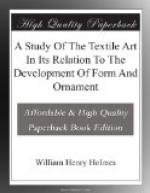Now the two types of construction, the interlaced and the twined, some primitive phases of which have been reviewed and illustrated, as they are carried forward in the technical progress of the art, exhibit many new features of combination and resultant surface character, but the elaboration is in all cases along lines peculiar to these types of weaving.
Other types of combination of web and woof, all tapestry, and all braiding, netting, knitting, crochet, and needle work exhibit characters peculiar to themselves, developing distinct groups of relieved results; yet all are analogous in principle to those already illustrated and unite in carrying forward the same great geometric system of combination.
Reticulated work.—A few paragraphs may be added here in regard to reticulated fabrics of all classes of combination, as they exhibit more than usually interesting relievo phenomena and have a decided bearing upon the growth of ornament.
In all the primitive weaving with which we are acquainted definite reticulated patterns are produced by variations in the spacings and other relations of the warp and woof; and the same is true in all the higher forms of the art. The production of reticulated work is the especial function of netting, knitting, crocheting, and certain varieties of needlework, and a great diversity of relieved results are produced, no figure being too complex and no form too pronounced to be undertaken by ambitious workmen.
In the following figures we have illustrations of the peculiar class of primitive experiments that, after the lapse of ages, lead up to marvelous results, the highest of which may be found in the exquisite laces of cultured peoples. The Americans had only taken the first steps in this peculiar art, but the results are on this account of especial interest in the history of the art.
An example of simple reticulated hand weaving is shown in Fig. 308. It is the work of the mound builders and is taken from an impression upon an ancient piece of pottery obtained in Tennessee.
[Illustration: Fig. 308. Incipient stage of reticulated ornament. Fabric of the mound builders.]
Fig. 309 illustrates a bit of ancient Peruvian work executed on a frame or in a rude loom, a checker pattern being produced by arranging the warp and woof now close together and now wide apart.
Open work of this class is sometimes completed by after processes, certain threads or filaments being drawn out or introduced, by which means the figures are emphasized and varied.
In Fig. 310 we have a second Peruvian example in which the woof threads have been omitted for the space of an inch, and across this interval the loose warp has been plaited and drawn together, producing a lattice-like band.
[Illustration: Fig. 309. Simple form of ornamental reticulation. Ancient Peruvian work.]
[Illustration: Fig. 310. Reticulated pattern in cotton cloth. Work of the ancient Peruvians.]




